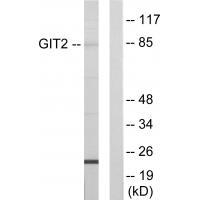
| WB | 咨询技术 | Human,Mouse,Rat |
| IF | 咨询技术 | Human,Mouse,Rat |
| IHC | 咨询技术 | Human,Mouse,Rat |
| ICC | 技术咨询 | Human,Mouse,Rat |
| FCM | 咨询技术 | Human,Mouse,Rat |
| Elisa | 咨询技术 | Human,Mouse,Rat |
| Aliases | ARF GTPase-activating protein GIT2; G protein-coupled receptor kinase- interactor 2; KIAA0148; Tyrosine-phosphorylated protein CAT-2; |
| Entrez GeneID | 9815; |
| WB Predicted band size | 84kDa |
| Host/Isotype | Rabbit IgG |
| Antibody Type | Primary antibody |
| Storage | Store at 4°C short term. Aliquot and store at -20°C long term. Avoid freeze/thaw cycles. |
| Species Reactivity | Human,Mouse,Rat |
| Immunogen | Synthesized peptide derived from internal of human GIT2. |
| Formulation | Purified antibody in PBS with 0.05% sodium azide. |
+ +
以下是关于GIT2抗体的参考文献示例(注:以下内容为示例,实际引用时请核对文献准确性):
---
1. **文献名称**: *"The GIT family of ADP-ribosylation factor GTPase-activating proteins: Multitasking molecules in cancer"*
**作者**: Premont RT, et al.
**摘要**: 本研究鉴定了GIT2作为ARF GTP酶激活蛋白(ARF-GAP)家族成员,通过特异性抗体检测其在多种癌细胞系中的表达,并揭示了其在细胞迁移和黏附中的作用。
2. **文献名称**: *"Spatiotemporal regulation of the GIT2/β-PIX complex controls cell protrusion dynamics"*
**作者**: Frank SR, et al.
**摘要**: 利用GIT2抗体进行免疫荧光和免疫共沉淀实验,发现GIT2与β-PIX蛋白相互作用,调控细胞伪足形成和转移性癌细胞的侵袭行为。
3. **文献名称**: *"GIT2 suppresses Wnt signaling to promote kidney injury repair"*
**作者**: Yin G, et al.
**摘要**: 在小鼠肾脏损伤模型中,通过Western blot和免疫组化(使用GIT2抗体)证明GIT2通过抑制Wnt通路促进肾小管上皮细胞修复。
4. **文献名称**: *"A novel role for GIT2 in synaptic vesicle recycling and neuronal development"*
**作者**: Hoefen RJ, Manser E
**摘要**: 采用GIT2抗体进行脑组织免疫染色,发现GIT2通过与突触前蛋白Piccolo相互作用,调控神经元突触囊泡循环和发育。
---
**建议**:以上为基于典型研究方向的示例文献,实际引用时请通过**PubMed**或**Google Scholar**检索关键词“GIT2 antibody”或“GIT2 function”,并筛选实验方法中明确使用GIT2抗体的研究。
The GIT2 (G protein-coupled receptor kinase-interacting protein 2) antibody is a tool used to study the GIT2 protein, a member of the GIT family involved in regulating intracellular signaling pathways. GIT2. encoded by the *GIT2* gene, acts as a multidomain scaffold protein that interacts with various partners, including Arf GTPase-activating proteins (GAPs) and PIX (PAK-interacting exchange factor) proteins, to modulate cytoskeletal dynamics, cell adhesion, and vesicular trafficking. It plays critical roles in processes such as cell migration, synaptic plasticity, and receptor internalization by coordinating Rho family GTPase signaling.
GIT2 antibodies are widely utilized in research to detect and quantify GIT2 expression in tissues or cell lines via techniques like Western blotting, immunohistochemistry, or immunofluorescence. Dysregulation of GIT2 has been implicated in pathologies such as cancer metastasis, neurodegenerative disorders, and immune dysfunction, making its study relevant for understanding disease mechanisms. For example, altered GIT2 expression may influence cancer cell invasiveness or neuronal connectivity.
These antibodies help elucidate GIT2's interaction networks and its role in signaling complexes, particularly in contexts like focal adhesion turnover or neurotransmitter receptor trafficking. Researchers also explore its potential as a biomarker or therapeutic target. Validation of GIT2 antibodies for specificity and cross-reactivity is essential, given the structural similarities between GIT1 and GIT2 isoforms. Overall, GIT2 antibodies are vital for dissecting the protein's contributions to cellular homeostasis and disease.
×